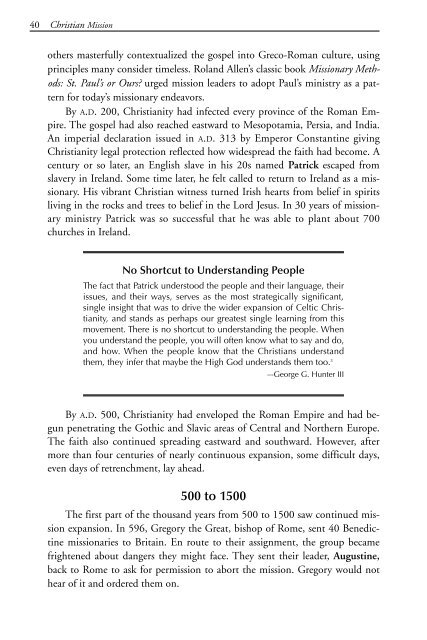discovering missions - Southern Nazarene University
discovering missions - Southern Nazarene University
discovering missions - Southern Nazarene University
Create successful ePaper yourself
Turn your PDF publications into a flip-book with our unique Google optimized e-Paper software.
245187 Disc Missions ins 9/6/07 1:04 PM Page 40<br />
40 Christian Mission<br />
others masterfully contextualized the gospel into Greco-Roman culture, using<br />
principles many consider timeless. Roland Allen’s classic book Missionary Methods:<br />
St. Paul’s or Ours? urged mission leaders to adopt Paul’s ministry as a pattern<br />
for today’s missionary endeavors.<br />
By A.D. 200, Christianity had infected every province of the Roman Empire.<br />
The gospel had also reached eastward to Mesopotamia, Persia, and India.<br />
An imperial declaration issued in A.D. 313 by Emperor Constantine giving<br />
Christianity legal protection reflected how widespread the faith had become. A<br />
century or so later, an English slave in his 20s named Patrick escaped from<br />
slavery in Ireland. Some time later, he felt called to return to Ireland as a missionary.<br />
His vibrant Christian witness turned Irish hearts from belief in spirits<br />
living in the rocks and trees to belief in the Lord Jesus. In 30 years of missionary<br />
ministry Patrick was so successful that he was able to plant about 700<br />
churches in Ireland.<br />
No Shortcut to Understanding People<br />
The fact that Patrick understood the people and their language, their<br />
issues, and their ways, serves as the most strategically significant,<br />
single insight that was to drive the wider expansion of Celtic Christianity,<br />
and stands as perhaps our greatest single learning from this<br />
movement. There is no shortcut to understanding the people. When<br />
you understand the people, you will often know what to say and do,<br />
and how. When the people know that the Christians understand<br />
them, they infer that maybe the High God understands them too. 3<br />
–-George G. Hunter III<br />
By A.D. 500, Christianity had enveloped the Roman Empire and had begun<br />
penetrating the Gothic and Slavic areas of Central and Northern Europe.<br />
The faith also continued spreading eastward and southward. However, after<br />
more than four centuries of nearly continuous expansion, some difficult days,<br />
even days of retrenchment, lay ahead.<br />
500 to 1500<br />
The first part of the thousand years from 500 to 1500 saw continued mission<br />
expansion. In 596, Gregory the Great, bishop of Rome, sent 40 Benedictine<br />
missionaries to Britain. En route to their assignment, the group became<br />
frightened about dangers they might face. They sent their leader, Augustine,<br />
back to Rome to ask for permission to abort the mission. Gregory would not<br />
hear of it and ordered them on.

















